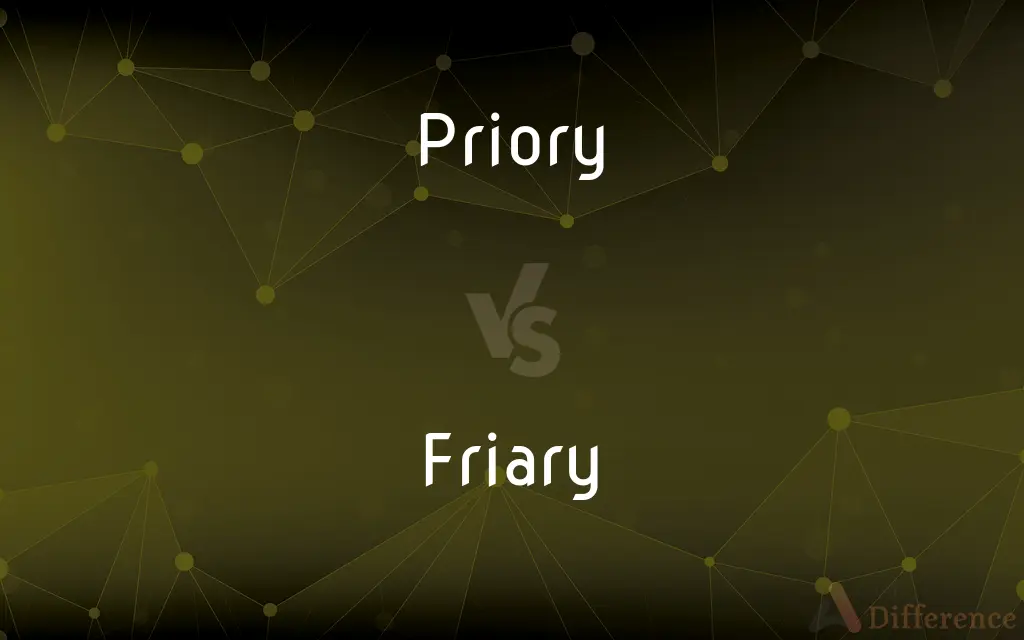Priory vs. Friary — What's the Difference?
By Maham Liaqat & Urooj Arif — Updated on April 24, 2024
Priory is a monastery governed by a prior, typically housing monks or nuns; whereas a friary is a residence or community of friars.

Difference Between Priory and Friary
Table of Contents
ADVERTISEMENT
Key Differences
A priory is a type of religious community or monastery governed by a prior or prioress and is often a subordinate house of a larger abbey. Whereas a friary is specifically a residence for friars, members of certain mendicant orders like the Franciscans or Dominicans.
Priors and prioresses in a priory typically oversee a community that could be either monks or nuns, following the rules of their religious order, such as the Benedictines or Augustinians. On the other hand, a friary is led by a guardian or superior but is more focused on apostolic and missionary work in the outside community.
Priories often have more of a contemplative nature, focusing on the internal life of prayer and work within the confines of the monastery. Whereas friaries involve more engagement with the external community, reflecting the mendicant calling to preach and serve the lay population.
The architectural style and layout of priories can vary widely, but they are generally more secluded and built for the purpose of solitary religious life. In contrast, friaries are often found in urban areas to facilitate interaction with the public and community service.
Many priories are ancient, with some converted into historical sites or tourist attractions, maintaining rich traditions and extensive properties. On the other hand, friaries are typically more integrated into the community's social and pastoral activities, with a focus on outreach and practical spirituality.
ADVERTISEMENT
Comparison Chart
Definition
A monastery governed by a prior, often linked to a larger abbey.
A residence or community of friars, usually mendicant religious orders.
Leadership
Governed by a prior or prioress.
Led by a guardian or superior.
Main Focus
Contemplative life, internal community focus.
Engagement with the external community, missionary work.
Typical Location
Secluded, often rural or in quiet settings.
Often urban, close to communities they serve.
Member Composition
Composed of monks or nuns.
Composed of friars.
Compare with Definitions
Priory
A religious house governed by a prior or prioress.
The ancient priory on the hill has been a spiritual retreat for centuries.
Friary
A place for religious brothers who live according to specific vows.
He joined the friary to live a life dedicated to serving others.
Priory
A place of religious seclusion and contemplation.
He spent a week in the priory to find peace and solitude.
Friary
Often located in urban areas to facilitate public engagement.
The new friary was established in the heart of the city to be closer to the community it serves.
Priory
A community of monks or nuns under the leadership of a prior.
She visited the priory to learn more about monastic life.
Friary
A residence or community of friars.
The local friary is known for its charity work.
Priory
A historic building, sometimes converted from a monastic use.
The old priory is now a museum showcasing medieval art.
Friary
A house belonging to a mendicant religious order.
The friary downtown provides shelter and meals to the homeless.
Priory
A smaller monastery, often subordinate to an abbey.
The priory serves as a dependency to the grand abbey nearby.
Friary
An establishment of friars engaged in missionary and outreach activities.
Members of the friary regularly volunteer at the city’s food bank.
Priory
A priory is a monastery of men or women under religious vows that is headed by a prior or prioress. Priories may be houses of mendicant friars or nuns (such as the Dominicans, Augustinians, Franciscans, and Carmelites), or monasteries of monks or nuns (as with the Benedictines).
Friary
A monastery of friars.
Priory
A monastery governed by a prior or a convent governed by a prioress.
Friary
House or dwelling where friars or members of certain religious communities live
Priory
A monastery or convent governed by a prior or prioress.
Friary
Like a friar; relating to friars or to a convent.
Priory
A religious house presided over by a prior or prioress; - sometimes an offshoot of, an subordinate to, an abbey, and called also cell, and obedience. See Cell, 2.
Friary
Like a friar; pertaining to friars or to a convent.
Priory
Religious residence in a monastery governed by a prior or a convent governed by a prioress
Friary
A monastery; a convent of friars.
Friary
The institution or practices of friars.
Friary
A monastery of friars
Common Curiosities
Are all priories part of larger religious institutions?
Many priories are dependent on or connected to larger abbeys, though some operate independently.
What is the historical significance of priories in medieval Europe?
Priories were vital centers of religious life, education, and manuscript preservation during the medieval period, often playing a significant role in local economies and cultural development.
Are there modern-day priories, and what do they look like?
Modern-day priories still exist, many maintaining traditional practices, while others may have adapted to contemporary needs, often featuring more modern facilities while preserving a contemplative atmosphere.
What kind of community outreach do friaries typically engage in?
Friaries often engage in community outreach such as providing social services, counseling, education, and healthcare, reflecting their commitment to serving those in need.
What is the primary role of a prior in a priory?
The prior or prioress is the head and administrative leader of a priory, overseeing the spiritual and daily operations of the monastery.
Can women be members of a friary?
Typically, friaries are composed of men as they are communities of friars; however, the female equivalent would involve nuns and would be called a convent or monastery.
Do priories and friaries serve the same religious function?
While both serve religious functions, priories are more focused on contemplative life, whereas friaries are actively involved in community service and missionary work.
How do friaries support themselves financially?
Friaries often engage in various forms of community work, donations, and sometimes partnerships with local organizations to support their missions.
How does the daily life of a friar differ from that of a monk in a priory?
Friars are generally more involved in external activities and community interactions, whereas monks in a priory focus more on internal community life and personal contemplation.
Can anyone visit a priory or friary?
Many priories and friaries are open to the public for visits, though some may have restrictions based on their community rules or religious observances.
Do friaries collaborate with other religious or secular organizations?
Yes, friaries frequently collaborate with other religious denominations and secular organizations to maximize their outreach and effectiveness in community service.
How do the vows taken by members of a priory differ from those taken by friars in a friary?
Members of priories typically take vows of stability, conversatio morum (fidelity to monastic life), and obedience; friars take vows like poverty, chastity, and obedience, emphasizing mobility and community service.
What role do priories play in the conservation of religious heritage?
Priories often serve as custodians of religious artifacts, manuscripts, and traditions, playing a crucial role in preserving religious heritage.
What types of architecture are distinctive to priories and friaries?
Priories often feature cloisters and secluded gardens, emphasizing solitude and meditation, whereas friaries might have simpler, more functional structures to accommodate their active community roles.
How do friaries impact local communities economically?
Friaries can have a significant economic impact on local communities through their provision of services, creation of employment, and attraction of visitors and pilgrims.
Share Your Discovery

Previous Comparison
Swear vs. Promise
Next Comparison
Winning vs. VictoryAuthor Spotlight
Written by
Maham LiaqatCo-written by
Urooj ArifUrooj is a skilled content writer at Ask Difference, known for her exceptional ability to simplify complex topics into engaging and informative content. With a passion for research and a flair for clear, concise writing, she consistently delivers articles that resonate with our diverse audience.















































